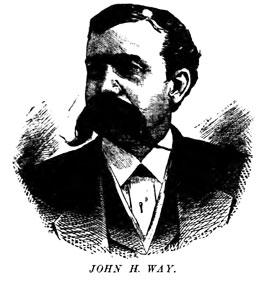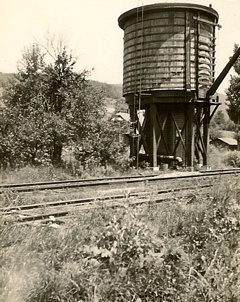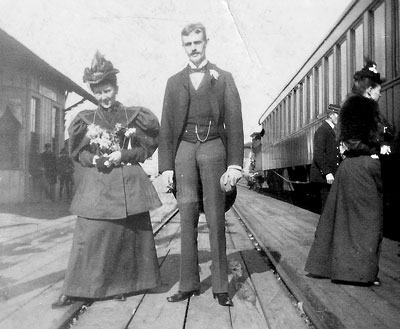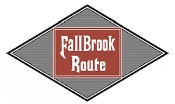
Conductor John H. Way
On Monday, January 16, 1888, John H. Way, who had been for thirty years a conductor on the Fall Brook railroad, resigned the situation and became chief clerk in the office of George R. Brown, General Superintendent of the Railroad Company. During his time with the Fall Brook, he became a close friend of Gen. George J. Magee, often accompanying him on hunting and other trips. He left the railroad by choice to take a business situation more to his liking and for a variety of reasons more desirable. His retirement from active service on the railroad which he served so long and faithfully, offers occasion for reminiscence.
 Mr. Way first became a conductor in 1857. He was then only twenty years of age. He was appointed by L. H. Shattuck, the then Superintendent of the Tioga Railroad, as Conductor of the mail train running from Corning to Blossburg, which route was in 1860 extended to Fall Brook. For twenty years he served in that capacity. When the Syracuse, Geneva and Corning Railroad was built by the Fall Brook Company in 1877, Conductor Way was placed in charge of the night and day express between Corning and Geneva, his run being extended to Lyons on the building of the branch to that place. He continued on that run until last Saturday, when he made his last trip as Conductor.
Mr. Way first became a conductor in 1857. He was then only twenty years of age. He was appointed by L. H. Shattuck, the then Superintendent of the Tioga Railroad, as Conductor of the mail train running from Corning to Blossburg, which route was in 1860 extended to Fall Brook. For twenty years he served in that capacity. When the Syracuse, Geneva and Corning Railroad was built by the Fall Brook Company in 1877, Conductor Way was placed in charge of the night and day express between Corning and Geneva, his run being extended to Lyons on the building of the branch to that place. He continued on that run until last Saturday, when he made his last trip as Conductor.
When he began railroading, there were only four locomotives on the road. Their names were Corning, Morris, Colket and Baltimore*. They were all wood-burners, and had to stop frequently at stations to get fuel. It was during the early part of his service that these locomotives were changed from wood-burners to coal burners. It was the first use of coal on that road as fuel for motive power. The change was an innovation - an experiment - but it "worked," and thereafter all the other locomotives - and subsequently those on the Erie Railroad - burned coal. It is an interesting fact that Conductor Way brought on his train the first supply of bituminous coal mined at Fall Brook, Pa. This was in 1860. The coal was shipped in four barrels. Two were shipped to W.E. Gregg, Master Mechanic of the Erie Railroad at Susquehannah; and the other two were for Reed Wilson, a coal agent at Buffalo. The coal was sent to them for trial, and for the purpose of introducing it in the market.
Conductor Way has seen the Fall Brook Railroad develop from small proportions into one of the busiest and most important iron thoroughfares in the East.
The four feeble wood-burning locomotives, which the old Tioga road had during his young Conductorship have given place to 62 powerful engines. When he first began his run, the coal and freight traffic was in its infancy. There was so little freight that one car, sent from Corning every other day, sufficed to hold all the freight articles consigned along the entire route from Blossburg. As for coal, the traffic in that was of course larger, but not more than 30 cars daily - or 4,500 tons monthly - were brought to Corning. That was all the coal that could be disposed of, to consumers north, east and west.
Now the freight traffic is immense, great trains running over the road daily, and 200,000 tons of coal on an average passing each month through Corning.
Conductor Way made an enviable record as a Conductor. It is but just to say that his record was ever free from spot or blemish. No railroad official was more attentive to duty, or more honorable in all his business relations. He won and retained the regard of his employers, by his conscientious and untiring efforts to discharge his duties with credit to himself and satisfaction to the travelling public. He never received a word of reprimand from the Company, and he never caused the loss of one dollar to his employers by reason of mistake or errors of judgement. He probably has as large an acquaintanceship as any man in the country. Thirty years is a long period, and in that time he has made thousands of intimate acquaintances who esteem him for his intelligence, his tact, and his undeviating courtesy.
During the last ten years his run has been through six Counties of this State. Starting from Corning - which, as the crow flies, is only nine miles from the Pennsylvania line - he has gone north through Steuben County, cutting through the northwest corner of Cheming, passing through Schuyler, up through the Counties of Yates and Ontario, and finally bringing up in Wayne County at Lyons, which is only eleven miles from Lake Ontario. He has made this trip daily and has thus practically crossed the Empire State every day for a decade. He estimates that during his thirty years as Conductor he has travelled one million miles - a distance equal to forty times around the globe. He is certainly worthy, from a life of veteran service, to have emeritus written after his name.
From the Corning Journal, January 19, 1888
Thanks to Richard Palmer for passing this on.
July 4, 1867 - On Tuesday forenoon several members of the Bloss Mining and Coal Company with a number of invited guests, went to Blossburg on a special train to visit the Mines of the new Company, and also those of Fall Brook and Morris Run .. Conductor Way was in charge of the train. (Corning Journal)
August 25, 1870 - John H. Way, Conductor on the Blossburg and Corning Railroad has just returned from an excursion to the Adirondack Woods. He went in company with George J. Magee, of Watkins. The two were for a fortnight camping out in the woods, fishing and hunting, and had a capital time. (Corning Journal)
December 12, 1872 - Last Friday about dark, the mail train on the Blossburg Railroad was approaching Corning, when a half mile west of the railroad bridge, an accident occurred ... an axle of one of the forward coal dumps broke, and several dumps were thrown off. The checking of the speed lifted the express car from the track, and also throw off the mail and baggage car ... the express car went down the river bank, and turned bottom up on the ice. There were four persons within ... One end of the car broke through the ice and water rushed in. Conductor Way was thrown down into that end, tubs of butter rolled against and upon him, the safe moved against the tubs and the stove fell across his feet ... One bone of the left forearm of Conductor Way was broken and he was much bruised on his head, body and limbs .. Mr. Way was helped out, and went forward to the engine and rode to this village... it was a very narrow escape for Mr. Way. He has been a conductor for fifteen years, and this is the first time he has been injured, or that any serious accident has happened to his train. (Corning Journal)
 May 2, 1873 - Most of our prominent citizens went to Watkins to attend the funeral of Mr. John Magee, Jr. A special train of four cars was run in charge of Supt. Gorton. Conductor Way, of Corning, was one of the pall-bearers. (Corning Journal)
May 2, 1873 - Most of our prominent citizens went to Watkins to attend the funeral of Mr. John Magee, Jr. A special train of four cars was run in charge of Supt. Gorton. Conductor Way, of Corning, was one of the pall-bearers. (Corning Journal)
May 28, 1874 - Mr. John H. Way was more than ten years a "conductor" on the road for the Tioga company and about four years for the Fall Brook Company, making in all a service of more than fourteen years upon the same road. By his courtesy, probity, honesty, and fidelity to the trust resposed in him, he has won the esteem of the campanies and become a favorite with the patrons of the road. (Corning Journal)
October 17, 1877 - The first passenger train from Corning through the new Syracuse, Geneva and Corning railroad arrived in Geneva about six o'clock last evening. It consisted of an engine and coach, and carried Gen. Geo. J. Magee, and officers and Directors of the road ... The party consisted of the following gentlemen: E. D. Worcester, D. W. Pardee, New York; C. H. Fisher, F. E. Worcester, J. Tillinghast, Albany; G. J. Magee, A. Hardt, J. H. Way, Daniel Beach, Watkins; A. H. Gorton, Corning; H. D. Opdyke, Jersey City; D. F. McPhwerson, Princeton, N. J.; Geo. H. Bowers, Rochester. (Geneva Courier)
December 12, 1877 - The new Syracuse, Geneva and Corning railroad was opened for passenger travel on Monday December 10, the first train leaving Geneva [south] at 8 a.m. on that day. The train left Albany at 6:45 a.m. and went over the Central and Corning roads to the Antrim and Fall Brook coal fields. It consisted of an engine, passenger coach and Wagner sleeper, and carried General George Magee, of Watkins, Hon C. C. B. Walker, of Corning, J. H. Rutter, Austin Lathrop, and other officials of the new road.
![]() The first train north arrived in Geneva about half past ten o'clock Monday morning a little behind schedule time. It left Corning at 7:20 a.m., and consisted of the locomotive "Lark," mail and express car No. 3, and the passenger coach "Wellsboro No. 6," all of the Fall Brook Coal Company. Mr. J. H. Way, for twenty years a conductor between Corning and Blossburg, was in charge, and Mr. Horace Lownsberry was the engineer.
The first train north arrived in Geneva about half past ten o'clock Monday morning a little behind schedule time. It left Corning at 7:20 a.m., and consisted of the locomotive "Lark," mail and express car No. 3, and the passenger coach "Wellsboro No. 6," all of the Fall Brook Coal Company. Mr. J. H. Way, for twenty years a conductor between Corning and Blossburg, was in charge, and Mr. Horace Lownsberry was the engineer.
![]() A new locomotive "Dundee," built at Schenectady, arrived for the Corning road on Monday. It drew a train of sixty flat cars for use on the road ...
A new locomotive "Dundee," built at Schenectady, arrived for the Corning road on Monday. It drew a train of sixty flat cars for use on the road ...
![]() (reprinted from Corning, December 10) About 11 o'clock this morning large crowd gathered at the Fall Brook Railroad depot to welcome the first passenger train over the new Corning and Geneva railroad ... The train consisted of baggage and passenger car, Wagner sleeper "Ilion," and Wagner drawiing room car "Duchess." The engine was the "Beaver," No. 18, J. Chapman, engineer and VanWormer fireman. Harry Krieger, one of the most popular of the Erie conductors, is conductor of the new run ... (Geneva Courier)
(reprinted from Corning, December 10) About 11 o'clock this morning large crowd gathered at the Fall Brook Railroad depot to welcome the first passenger train over the new Corning and Geneva railroad ... The train consisted of baggage and passenger car, Wagner sleeper "Ilion," and Wagner drawiing room car "Duchess." The engine was the "Beaver," No. 18, J. Chapman, engineer and VanWormer fireman. Harry Krieger, one of the most popular of the Erie conductors, is conductor of the new run ... (Geneva Courier)
December 27, 1877 - Conductor John Way who has been for a score of years conductor between Corning and Fall Brook, is now one of the conductors between Corning and Geneva. (Corning Journal)
June 12, 1878 - J. H. Way, formerly conductor on the Tioga Railroad, writes an article on fishing and hunting in Maine for Wilkes Spirit of the Times. Mr. Way is now one of the most popular conductors on the Syracuse, Geneva & Corning Railroad. (Geneva Courier)
January 30, 1879 - The Elmira Advertiser calls Conductor Way, of the S. G. & C. Railway - who showed such courage when his train was blockaded in the snow recently at night, between Reading Center and Rockstream, "A lion-hearted Conductor." It is a well-merited compliment. (Watkins Express)
January 8, 1883 - Last Saturday evening the passenger train that leaves Corning for Lyons at 8:30, had a collision with a coal train about 4 miles north of Corning. .. Conductor Way was thrown to the floor by the shock and severely bruised ... Gen. Geo. J. Magee and Daniel Beach were returning to Watkins, were somewhat bruised as were the others who were in the coaches. Conductor Way walked to Corning, and notified Superintendent Gorton, who went to the scene in the Switch Engine, taking a number of men, and also Dr. May ... Conductor Way did not realize his own injuries, or he would not have undertaken to walk to Corning. It was all he could do to get here, and he has not yet been able to leave his house. (Corning Journal
March 4, 1887 - One of the most courteous and gentlemanly conductors on the Syracuse, Geneva & Corning railroad is Mr. J. H. Way (Geneva Gazette)
January 25, 1888 - Conductor John H. Way of the Fall Brook road, has been designated chief clerk in the office of the General Superintendent at Corning. (Watkins Democrat)
January 7, 1890 - John H. Way, chief clerk in the General Superintendent's office of the Fall Brook Coal Company, died last Saturday afternoon at his home in Corning ... was known to a great many people in the county as a popular and genial conductor running between Blossburg and Corning for a long series of years. (Wellsboro Agitator)
* There is some disagreement about the correct names here.

Photo: Off on a honeymoon from Dresden, NY. (Beach Family Collection)
